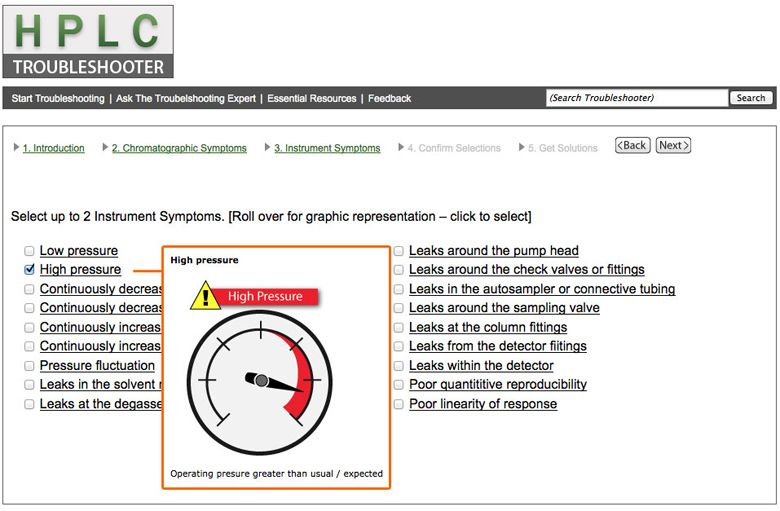The LCGC Blog: Four Steps to Troubleshooting an HPLC Problem
What if we could make the troubleshooting poster on the laboratory wall come to life? What if we could build an engine which figured out the most likely causes of groups of symptoms and offer these up as a prioritised list for folks to work through and give them supporting information on each problem, why it occurred, how to fix it and, crucially, how to avoid it happening next time?
"Oh, Larry got laid off..."
Strange opening?
It's the words that I heard on a visit to a lab just outside Boston, Massachusetts, which prompted me to embark on a project that my colleagues said was "too big."
I've seen many analytical chemists struggle with HPLC problems, from baseline issues to poorly constructed methods, from issues with changing retention times to gradient irreproducibility -particularly when the go-to expert in their lab - their "Larry" - got laid off.
I've seen them hunt for advice online, with colleagues, in forums, from vendors and service providers. Sometimes they get the answer they need, sometimes not – but it always takes time and effort. They learn a lot during the process, but the process is inefficient.
What if we could capture the knowledge which is held within those resources and bring it together in a single place?
What if we could make the troubleshooting poster on the laboratory wall come to life? What if we could build an engine which figured out the most likely causes of groups of symptoms and offer these up as a prioritised list for folks to work through and give them supporting information on each problem, why it occurred, how to fix it and, crucially, how to avoid it happening next time?
That's why my colleagues said it was too big.
Turns out they were wrong. It was a big project all right, but with the help of some very talented folks at Crawford Scientific, we did it. Here's the recipe;
- Make a list of all the common chromatographic and instrument symptoms you can think of.
- Build a questionnaire which asks dozens of expert chromatographers worldwide what problems, in their experience, most often lead to the listed symptoms.
- Collate all of the data into a database which links expert knowledge of symptoms with causal factors (there are thousands and thousands of lines in this database as you might imagine).
- Build an algorithm which allows users to select 'groups' of symptoms (both chromatographic and instrument related) and which presents the end user with a list of things to check and fix in priority order (the really clever bit……I can claim no credit here!).
- Serve up this list so that for each potential cause of the problem you have a 'quick fix guide,' because we need to sort the problem and get data flowing again. However also serve up, with each problem, a longer reading and resources list to make sure the end user understands why the problem occurred and how it might be avoided in the future.
It took over two years to "cook" the HPLC Troubleshooter. I've shown the general flow of how it works below.
Step 1: Select the chromatographic symptoms (if any) from the roll over list – here we had an issue with a change in separation selectivity.

Step 2: Select the instrument / hardware symptoms (if any) from the roll over list – in this situation we also noted that the back pressure was slightly higher than usual.

Step 3: Here's the list of things to check – in priority order against the confidence rating (number of stars) and the number of symptoms which were matched.

Step 4: Here's the 'quick fix' information and all of the supporting information should I wish to understand the problem more thoroughly and help prevent it happening again. It turned out that suggestion number 6 on the list was correct – the column had become contaminated with sample matrix residues. However it didn't take us long to work through the suggestions list and either check or discount the other suggested causes.

I've made this piece very brief this month because I would very much like you to spend the time investigating our digital version of Larry - http://www.chromacademy.com/hplc_troubleshooting.html
Oh, and if you're a GC person – we spent another two years building a replacement for Barry, who also got let go. http://www.chromacademy.com/gc_troubleshooting.html
Of course we could NEVER hope to replace the amount of knowledge which leaves a lab when our experts retire or 'move on' – I respect that entirely. However, I hope you think that the effort to mitigate this loss of knowledge was worthwhile. If you can think of ways to improve these tools for the good of the whole user community – please let me know at tony@crawfordscientific.com
For more information, contact either Bev (bev@crawfordscientific.com) or Colin (colin@crawfordscientific.com). For more tutorials on LC, GC, or MS, or to try a free LC or GC troubleshooting took, please visit www.chromacademy.com
.
The LCGC Blog: Historical (Analytical) Chemistry Landmarks
November 1st 2024The American Chemical Society’s National Historic Chemical Landmarks program highlights sites and people that are important to the field of chemistry. How are analytical chemistry and separation science recognized within this program?

.png&w=3840&q=75)

.png&w=3840&q=75)



.png&w=3840&q=75)



.png&w=3840&q=75)